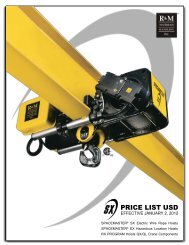Download - R&M Materials Handling equipment
Download - R&M Materials Handling equipment
Download - R&M Materials Handling equipment
Create successful ePaper yourself
Turn your PDF publications into a flip-book with our unique Google optimized e-Paper software.
Service Manual<br />
ControlMaster Plus Travel (CMPT)<br />
Adjustable Frequency Drive<br />
Service Manual
R&M <strong>Materials</strong> <strong>Handling</strong>, Inc.<br />
4501 Gateway Boulevard<br />
Springfield, Ohio 45502<br />
☎ : (937) 328-5100<br />
FAX: (937) 325-5319<br />
I Read the instructions supplied with the hoist before installation and commissioning.<br />
F Keep the instructions in a safe place for future reference.<br />
Table of content<br />
EN R_(EN)<br />
1 General............................................................3<br />
1.1 Technical data .............................................3<br />
1.2 Type mark coding........................................4<br />
1.3 Basic description .........................................4<br />
1.4 Main components ........................................5<br />
1.5 Functional description .................................5<br />
1.6 Control methods ..........................................6<br />
1.6.1 Description of the control methods, EP.......... 7<br />
1.6.2 Description of the control methods, EP3........ 7<br />
1.6.3 Description of the control methods, MS ......... 8<br />
1.7 Mechanical brake control ............................8<br />
2 Start-up procedure.........................................9<br />
2.1 Visual checks...............................................9<br />
2.2 Checks before the first test run...................9<br />
2.3 Test run ..................................................... 10<br />
2.4 After the test run........................................ 10<br />
3 Service........................................................... 11<br />
4 Troubleshooting........................................... 12<br />
4.1 Inverter fault codes.................................... 12<br />
5 Drawings....................................................... 16<br />
5.1 Description of terminals............................. 16<br />
5.1.1 Terminal in 002-011F ..................................16<br />
5.1.2 Terminal in 015F.........................................18<br />
6 Parameter adjustments............................... 19<br />
6.1 The display panel ...................................... 19<br />
6.2 Programming principles ............................ 20<br />
7 Parameter descriptions............................... 21<br />
2/25<br />
R&M <strong>Materials</strong> <strong>Handling</strong>, Inc. reserves the right to alter or amend the above information without notice.
R&M <strong>Materials</strong> <strong>Handling</strong>, Inc.<br />
4501 Gateway Boulevard<br />
Springfield, Ohio 45502<br />
☎ : (937) 328-5100<br />
FAX: (937) 325-5319<br />
1 General<br />
I CAUTION<br />
• Before starting, carefully read these instructions and this table.<br />
• Verify that all connections are according to the electrical drawings.<br />
• Verify that the motor supply is connected correctly. An improper connection will destroy the inverter.<br />
• Verify that the internal voltage selections of the device are correct.<br />
• Check that the device cover is properly installed and all ventilation holes are clear and uncovered.<br />
• Check that the hot air coming from brake resistors does not cause any danger.<br />
• High voltages are present in this device. Do not make any inspections until the power supply has<br />
been disconnected at the main switch. Before opening the device cover, wait at least 5 minutes after<br />
the display lamps turn off.<br />
• An insulation resistance test, using a megger, requires special precautions.<br />
• Do not make any measurements inside the device when it is connected to the main supply.<br />
• Do not touch the IC-circuits on the circuit boards. Static voltage discharge may destroy the<br />
components.<br />
• It is forbidden to use radiophones and portable phones near this device with the enclosure doors<br />
open.<br />
• All the doors and covers must be closed during crane operation.<br />
1.1 Technical data<br />
Power class 002F 003F 004F 005F 007F 011F 015F<br />
Power (kVA) at 400V 4.5 5.5 7 9 13 17 22<br />
Output current In (A) 6.5 8 10 13 18 24 32<br />
Max. current 1min (A) 10 12 15 20 27 36 48<br />
Overload ability<br />
1.5 x In , 1min/10min / 2.5 x In , 2s/20s (
R&M <strong>Materials</strong> <strong>Handling</strong>, Inc.<br />
4501 Gateway Boulevard<br />
Springfield, Ohio 45502<br />
☎ : (937) 328-5100<br />
FAX: (937) 325-5319<br />
Momentary power loss<br />
Immediate fault stop<br />
Inverter overtemperature<br />
Temperature sensor on the heat sink<br />
Mechanical brake<br />
Circuit breaker<br />
Braking transistor<br />
Electronic supervision<br />
Ground fault<br />
Provided by electronic circuitry<br />
Ambient conditions<br />
Ambient temperature<br />
-10°C ... +55°C (14°F ... 131°F) for ED≤60%<br />
Storage temperature<br />
-40°C ... +60°C (-31°F ... 140°F) dry<br />
Humidity<br />
R&M <strong>Materials</strong> <strong>Handling</strong>, Inc.<br />
4501 Gateway Boulevard<br />
Springfield, Ohio 45502<br />
☎ : (937) 328-5100<br />
FAX: (937) 325-5319<br />
Limit switch functions<br />
Protections<br />
available with ev ery Adjustable Frequency Drive.<br />
The Adjustable Frequency Drive has built-in slowdown and stop limit switch functions for both running<br />
directions.<br />
The Adjustable Frequency Drive includes a motor thermal protection, which is based on motor temperature<br />
measurement by thermistors placed in motor windings. Other protections that may be included Adjustable<br />
Frequency Driveare shown in the technical data.<br />
1.4 Main components<br />
The main components are:<br />
A1<br />
Inverter<br />
F7<br />
Circuit breaker<br />
K7<br />
Brake contactor<br />
G1 Brake control unit REC12 002-011<br />
G1 Brake control unit ESD141 015<br />
The most important external components are:<br />
R1<br />
M1<br />
Y1<br />
B6<br />
Braking resistor unit<br />
Traveling motor<br />
Mechanical brake<br />
Thermal sensor for motor protection<br />
Control devices (switches, pushbuttons etc.)<br />
Limit switches<br />
1.5 Functional description<br />
Operation when power is switched on<br />
• The contacts of the limit switches-S11, S12, S21 and S22 and the Emergency Stop button-ES are<br />
normally closed.<br />
• The control voltage is supplied to terminal X1:37. The main voltage is connected to inverter power<br />
supply and the inverter powers up. If the control voltage is connected to RDY-signal and the fault<br />
circuit is OK, inverter is ready to operate in about 1-2 seconds.<br />
• If either of the direction signals-S1 or S2 is on, the display shows F52 and driving can begin only after<br />
the direction signals have been off for a while.<br />
Normal operation<br />
• For the description of the speed reference setting see chapters "Control methods" and "Parameter<br />
Descriptions".<br />
• Running starts when switch-S1 (S2) closes. Closing contact ROB2 on inverter-A1 energizes brake<br />
contactor-K7, which opens the brake. The Adjustable Frequency Drive accelerates according to the<br />
acceleration ramp setting to the selected speed.<br />
• When switch-S1 (S2) opens, the Adjustable Frequency Drive stops according to the deceleration<br />
ramp setting and the brake closes.<br />
• Braking resistor unit-R1 dissipates the regenerated energy during deceleration. The power supply to<br />
R1 is controlled by A1. If the braking resistor fan(s) are included in the Adjustable Frequency Drive,<br />
the cooling device will operate when power is supplied to the braking resistors. The cooling continues<br />
for about 4-5 minutes after the occurrence of electrical braking. This is to ensure that the temperature<br />
of the resistors stays below 150°C (302°F).<br />
Other features<br />
5/25<br />
R&M <strong>Materials</strong> <strong>Handling</strong>, Inc. reserves the right to alter or amend the above information without notice.
R&M <strong>Materials</strong> <strong>Handling</strong>, Inc.<br />
4501 Gateway Boulevard<br />
Springfield, Ohio 45502<br />
☎ : (937) 328-5100<br />
FAX: (937) 325-5319<br />
• By opening the slowdown limit switches-S11 and S21, the maximum speed can be limited. The<br />
slowdown speed is adjustable by parameter.<br />
• If contact RDY opens for any reason, operation of the inverter is stopped.<br />
• The thermistor relay function is used when needed.<br />
• When the stop limit switch, S12 or S22 opens, K7 de-energizes and the mechanical brake stops the<br />
motion.<br />
• The extended speed range ESR can be used, if the signal FWE (field weakening enabled) is turned<br />
on.<br />
1.6 Control methods<br />
There are three different control methods (command modes) available:<br />
1 EP2 Electronic motor potentiometer function.<br />
Stepless control using a 2-step pushbutton controller.<br />
2 EP3 Electronic motor potentiometer function.<br />
Stepless control using a 3-step controller.<br />
3 MS Multistep control (4 steps)<br />
The control mode is selected by parameter P2.1.4. The parameters assign digital inputs S1, S2, OK,<br />
DIA3-DIA5 and DID1-DID5. It is not possible to change the functions of the inputs individually. The input<br />
assignment according to the selected mode is explained in the following table.<br />
Control mode EP EP3 MS<br />
Parameter P2.1.4 1 2 3<br />
Signal<br />
Terminal<br />
S1 X1:8 S1 S1 S1<br />
S2 X1:9 S2 S2 S2<br />
OK X1:7 OK OK OK<br />
DIA3 X1:10 AP AP MS2<br />
DIA4 X1:11 Not used HOLD MS3<br />
DIA5 X1:12 Not used not used MS4<br />
DID1 X1:38 FWE FWE FWE<br />
DID2 X1:39 S11 S11 S11<br />
DID3 X1:40 S21 S21 S21<br />
DID4 X1:41 S12 S12 S12<br />
DID5 X1:42 S22 S22 S22<br />
Desired speed levels for multi-step control mode are selected with following parameters<br />
Speed Parameter Input<br />
Speed 1 P2.2.8. / P2.2.9. S1/ S2<br />
Speed 2 P2.1.7. MS 2<br />
Speed 3 P2.1.8. MS 3<br />
Speed 4 P2.1.9. MS 4<br />
6/25<br />
R&M <strong>Materials</strong> <strong>Handling</strong>, Inc. reserves the right to alter or amend the above information without notice.
R&M <strong>Materials</strong> <strong>Handling</strong>, Inc.<br />
4501 Gateway Boulevard<br />
Springfield, Ohio 45502<br />
☎ : (937) 328-5100<br />
FAX: (937) 325-5319<br />
1.6.1 Description of the control methods, EP2<br />
c_coep2a<br />
0. Decelerate<br />
1. Maintain speed<br />
2. Accelerate<br />
A. Pushbutton position<br />
B. Speed<br />
EP2-control uses a 2-step pushbutton. The operation is as follows:<br />
- Rest position means standstill (0-position)<br />
- During run, rest position means deceleration<br />
- Step one (switch S1 or S2) means hold speed<br />
- When starting, step one means acceleration up to the minimum speed<br />
- Step two (switch AP) means acceleration (up to the maximum speed if desired)<br />
- At the maximum speed step two means hold speed, because the maximum speed cannot be exceeded<br />
1.6.2 Description of the control methods, EP3<br />
c_coep3a<br />
0. Decelerate<br />
1. Minimum speed<br />
2. Maintain speed<br />
3. Accelerate<br />
A. Pushbutton position<br />
B. Speed<br />
EP3-control uses a 3-step controller. The operation is as follows:<br />
- Rest position means standstill (0-position)<br />
- Step one (switch S1 or S2) is the minimum speed command<br />
- Step two (EP hold command) means hold speed<br />
- Step three (switch AP) means acceleration (up to the maximum speed if desired)<br />
- When releasing the controller, step one means deceleration down to the minimum speed<br />
7/25<br />
R&M <strong>Materials</strong> <strong>Handling</strong>, Inc. reserves the right to alter or amend the above information without notice.
R&M <strong>Materials</strong> <strong>Handling</strong>, Inc.<br />
4501 Gateway Boulevard<br />
Springfield, Ohio 45502<br />
☎ : (937) 328-5100<br />
FAX: (937) 325-5319<br />
1.6.3 Description of the control methods, MS<br />
c_coms4a<br />
A. Pushbutton position<br />
B. Speed<br />
MS-control uses a 2-step pushbutton, or 3, 4-step controller. The operation is as follows:<br />
- Each step has its own frequency<br />
- Frequencies are freely selectable<br />
- When the pushbutton/controller is set to a certain step, the speed changes to equal value<br />
1.7 Mechanical brake control<br />
The Adjustable Frequency Drive includes a brake contactor to control the electromechanical brake. The<br />
brake operates on DC-voltage. When power is removed to the brake, a spring force closes the brake.<br />
The brake is controlled to remain closed until the motor first generates enough starting torque and then<br />
the brake is opened. The same applies for stopping;, the motor still generates torque while the brake is<br />
being closed. During a direction change, the brake is kept open all the time. After the run command is<br />
switched off, the Adjustable Frequency Drive decelerates the motor to a stop according to the preset<br />
deceleration time. The brake is used as a holding brake, and this way, wear on the brake is minimized.<br />
However, if a failure occurs or the Emergency Stop button is pushed, the brake closes immediately,<br />
stopping the motor and the load.<br />
Models 002F-005F use a REC12 brake control unit, which is a line voltage, half-wave rectifier. The halfwave<br />
rectifier reduces losses and is enough to open the brake. A contactor switches the line voltage on<br />
and off.<br />
Models 007F-015F use an ESD141 brake control unit, which is a line voltage, full/half-wave rectifier. Fullwave<br />
rectification is used to open the brake quickly. Then, the rectifier changes over to half-wave, which<br />
reduces losses, but is enough to hold the brake open. A contactor switches the line voltage on and off.<br />
The same contactor also disconnects the DC-voltage directly from the brake coil, which assures that the<br />
brake closes fast.<br />
8/25<br />
R&M <strong>Materials</strong> <strong>Handling</strong>, Inc. reserves the right to alter or amend the above information without notice.
R&M <strong>Materials</strong> <strong>Handling</strong>, Inc.<br />
4501 Gateway Boulevard<br />
Springfield, Ohio 45502<br />
☎ : (937) 328-5100<br />
FAX: (937) 325-5319<br />
2 Start-up procedure<br />
If any problems or malfunctions occur during the start-up, refer to the Chapter “Troubleshooting”, to find<br />
out the reason. All problems must be solved before continuing. For more information, contact craneservice<br />
personnel.<br />
I Warning! High voltages inside the device. Wait for at least five minutes after the supply<br />
voltage has been switched off before servicing. Display in operating condition (lights on)<br />
indicates a dangerous voltage on the DC-bus. When the display turns off, the DC-bus<br />
voltage is about 100V. Note also that there is a dangerous voltage in the braking resistor<br />
when the DC-bus is charged.<br />
F Do not connect any voltage to the output terminals (U, V, W). Otherwise, the inverter will be<br />
damaged.<br />
F The overload protection protects both the supply and the motor cables. The fuses of the supply<br />
provide short circuit protection.<br />
2.1 Visual checks<br />
- Check the condition of cubicles.<br />
- Check that the Adjustable Frequency Drive serial number is the same as in delivery documents.<br />
- Check the cabling/wiring to the motor, brake, and thermistors.<br />
- Check the motor type.<br />
- Check the wire terminations in the motor connection box<br />
- Check the wire connections for motor, thermistors and brake wear.<br />
- Disconnect motor leads (U, V, W) and brake wires to prevent damage to the inverter. Measure isolation<br />
resistance of brake coil and motor windings (each phase to ground).<br />
- Re-connect motor leads and brake wires.<br />
- Check the braking resistor.<br />
- Terminals, X1:21-27 and X1:51-57 are for electronics level signals.<br />
- Normally only shielded wires are connected to these terminals. Check that no control or line-voltage level wires<br />
are connected there.<br />
2.2 Checks before the first test run<br />
I Warning! High voltages inside Adjustable Frequency Drive.<br />
- Check the power supply voltage (nominal voltage +/- 10%).<br />
- Check the control voltage (nominal voltage +/- 10%).<br />
- Make sure that the run commands are off (pushbuttons / controller (master switch) at zero position).<br />
- Turn on the power from the main switch and the control voltage switch.<br />
- Within about 1 second, the control panel should display "AC on", and then in about 1 second the display<br />
changes to motor output frequency "0.00" and the green READY status indicator turns on.<br />
- In a fault situation the red FAULT status indicator blinks and the display shows a fault code instead of<br />
frequency.<br />
- Check that the green RUN status indicator is off.<br />
- Check that the external connections and the selected input set, P 2.1.4. are according to application.<br />
- Parameters are properly set after the factory tests and adjustments are not needed except for the parameters<br />
that depend on the crane application. Write down to the parameter list all the values that have been changed<br />
and at the end save parameters to display file 2.<br />
9/25<br />
R&M <strong>Materials</strong> <strong>Handling</strong>, Inc. reserves the right to alter or amend the above information without notice.
R&M <strong>Materials</strong> <strong>Handling</strong>, Inc.<br />
4501 Gateway Boulevard<br />
Springfield, Ohio 45502<br />
☎ : (937) 328-5100<br />
FAX: (937) 325-5319<br />
2.3 Test run<br />
- Make sure that the movement will not cause any danger to the environment or to the crane itself. Avoid driving<br />
close to the limit areas.<br />
- Check limit switches manually if possible.<br />
- Check the run commands on display panel matches the traveling direction. The arrow rotates clockwise if S1<br />
(right/forward) is applied and counter-clockwise if S2 (left/backward) is applied.<br />
- Drive forward at minimum speed for 5 to 10 seconds. Accelerate to full speed. Run 5 to 10 seconds. Stop.<br />
Repeat the same in the reverse direction. Check the frequency display to make sure that the frequency<br />
changes through the whole operational frequency range from minimum to nominal speed.<br />
- Check the motor operation (acceleration, deceleration and braking): accelerate to full speed forward, change to<br />
full speed backward and full speed forward again and stop.<br />
- Check the limit switch functions: drive slowly to limit switches and check the slowdown and stop limit switch<br />
operations. Re-check using full speed. Repeat the same check for the other direction.<br />
- If the optional ESR is used, check the maximum frequency as stated in the testing table.<br />
2.4 After the test run<br />
- Record all parameter value changes in the parameter list.<br />
- Make sure all remarks and setting values are recorded.<br />
- It is recommended to store the parameter settings in the memory of the display panel, file 2.<br />
10/25<br />
R&M <strong>Materials</strong> <strong>Handling</strong>, Inc. reserves the right to alter or amend the above information without notice.
R&M <strong>Materials</strong> <strong>Handling</strong>, Inc.<br />
4501 Gateway Boulevard<br />
Springfield, Ohio 45502<br />
☎ : (937) 328-5100<br />
FAX: (937) 325-5319<br />
3 Service<br />
The Adjustable Frequency Drive does not require regular maintenance. The following actions are<br />
recommended:<br />
• Check inverter fault history<br />
Find out the reasons of any possible faults<br />
Clear the fault history<br />
• Clean the heat sink on the inverter<br />
Prevent the dust to spread inside cubicles<br />
Lock the fans before blowing compressed air<br />
• Check that there are no abnormal noises coming from the cooling fans<br />
• Tighten all screws and connectors<br />
• Clean the dust from PC-boards<br />
F The parameters are saved in an EEPROM, which keeps the parameters in memory after power off<br />
without any battery backup.<br />
11/25<br />
R&M <strong>Materials</strong> <strong>Handling</strong>, Inc. reserves the right to alter or amend the above information without notice.
R&M <strong>Materials</strong> <strong>Handling</strong>, Inc.<br />
4501 Gateway Boulevard<br />
Springfield, Ohio 45502<br />
☎ : (937) 328-5100<br />
FAX: (937) 325-5319<br />
4 Troubleshooting<br />
I Warning! High voltages inside the frequency converter. Wait for at least five minutes after<br />
the supply voltage has been switched off before servicing. Display in operating condition<br />
(lights on) indicates a dangerous voltage on the DC-bus. When the display turns off, the DCbus<br />
voltage is about 100V. Note that there is a dangerously high voltage in the braking<br />
resistor when the DC-bus is charged.<br />
This chapter describes how to troubleshoot inverter faults. The purpose is to find out which components<br />
are damaged and how to replace or restore them for proper operation. Advice is also given to find the<br />
possible external failures that could affect the Adjustable Frequency Drive function.<br />
4.1 Inverter fault codes<br />
If any one of the following faults occurs, the inverter displays the fault code and the operation of the<br />
crane/hoist is stopped. If several faults occur one after another, the latest one is displayed, while the<br />
others are stored to the fault history page on the inverter. The Adjustable Frequency Drive includes an<br />
automatic fault reset operation; the fault code stays on the display until the fault is removed and the<br />
controller is released back to 0-position. Some of the fault codes require to switch the power off before<br />
run is possible.<br />
When the fault supervision trips, the FAULT indicator turns on and the blinking fault code “F xx“ (xx =<br />
fault number) appears on the display. The faults are stored to the fault history; from there they can be<br />
seen if necessary.<br />
Fault<br />
code<br />
12/25<br />
Fault Possible cause Checking<br />
F 1 Overcurrent Inverter has measured too high current (over<br />
4*In) in the motor output:<br />
sudden heavy load increase<br />
short circuit in the motor or cable<br />
not suitable motor<br />
wrong motor parameters<br />
F 2 Overvoltage DC-bus voltage has exceeded 135% maximum<br />
level, 911Vdc (F-series), 1258 Vdc (K-series)<br />
supply voltage raised >1.35 x Un<br />
(high overvoltage spikes at<br />
mains)<br />
deceleration time is too short<br />
Reset: switch power off and restart after the<br />
lamps of display are off.<br />
Check:<br />
motor type and power rating<br />
parameters<br />
motor cables<br />
motor insulation<br />
brake operation<br />
motor loading<br />
Check:<br />
adjust the deceleration time<br />
longer<br />
measure main supply voltage<br />
level and wave form while not<br />
driving<br />
motor insulation<br />
motor cable insulation (phaseground,<br />
phase-phase)<br />
braking resistor cable<br />
braking resistor type and<br />
resistance<br />
braking chopper operation<br />
R&M <strong>Materials</strong> <strong>Handling</strong>, Inc. reserves the right to alter or amend the above information without notice.
R&M <strong>Materials</strong> <strong>Handling</strong>, Inc.<br />
4501 Gateway Boulevard<br />
Springfield, Ohio 45502<br />
☎ : (937) 328-5100<br />
FAX: (937) 325-5319<br />
13/25<br />
F 3 Earth fault Current measurement has sensed unbalance in<br />
motor phase currents. Supervision level is 5% of<br />
inverter nominal current<br />
not symmetric load<br />
insulation failure in the motor or<br />
the cables<br />
F 4<br />
Unknown<br />
F 5 Charging switch Charging switch is open when START command<br />
becomes active<br />
interference fault<br />
component failure<br />
F 6 Emergency Stop Either the ES or RDY-signal has<br />
been tripped during<br />
Reset: switch power off and res tart after the<br />
lamps of display are off.<br />
Check:<br />
motor insulation<br />
motor cable insulation (phaseground,<br />
phase-phase)<br />
Reset: sw itch power off and restart after the<br />
lamps of display are off.<br />
Check:<br />
control unit and power unit<br />
connections<br />
charging resistors<br />
If the fault comes again, change<br />
the control unit.<br />
Check:<br />
ES and RDY external<br />
connections<br />
brake operation<br />
F 7 Saturation trip Very high overload or defective component Reset: switch power off and restart after the<br />
lamps of display are off.<br />
Check:<br />
motor and motor cable insulation<br />
measure main circuit diodes and<br />
IGBT transistors<br />
If the fault comes again, change<br />
the power unit.<br />
F 8<br />
Unknown<br />
F 9 Undervoltage DC-bus voltage has dropped below 65% of<br />
rectified supply voltage<br />
main supply voltage
R&M <strong>Materials</strong> <strong>Handling</strong>, Inc.<br />
4501 Gateway Boulevard<br />
Springfield, Ohio 45502<br />
☎ : (937) 328-5100<br />
FAX: (937) 325-5319<br />
F 13<br />
F 14<br />
F 22<br />
F 23<br />
F 24<br />
F 25<br />
14/25<br />
Inverter<br />
undertemperature<br />
Inverter<br />
overtemperature<br />
EEPROM<br />
checksum fault<br />
Changed data<br />
warning<br />
Microprocessor<br />
watchdog-fault<br />
Temperature of heat sink is below acceptable<br />
operating level (-10°C /14°F)<br />
Temperature of heat sink is over acceptable<br />
operating level<br />
+80°C (176°F).<br />
Overtemperature warning is issued when the<br />
heat sink temperature exceeds +75°C (167°F)<br />
Parameter restoring error<br />
interference fault<br />
component failure (control unit)<br />
faulty supply voltage<br />
programming<br />
Changes may have occurred in the different<br />
counter data due to mains interruption<br />
interference fault<br />
component failure (control unit)<br />
F 26 Power Unit Fault<br />
F 32 Fan cooling fault Cooling fan of the frequency converter do not<br />
work, when ON command has been given<br />
F 33 Memory fault<br />
F 34 Communication<br />
fault<br />
F 35 Application fault Run-time exception in the application program<br />
chopper is broken<br />
Contact service<br />
Check<br />
ambient temperature<br />
cubicle heating<br />
Check:<br />
ambient temperature<br />
fan operation<br />
cooling air flow through heat sink<br />
heat sink is not dusty<br />
After power is off, the inverter will automatically<br />
load factory-default parameter settings. Drive<br />
does not work properly nor enable driving after<br />
this fault.<br />
Check:<br />
all parameter settings.<br />
If the fault comes again, contact<br />
service.<br />
No special actions required. Take a critical<br />
attitude to the counter data.<br />
Reset: switch power off and restart after the<br />
lamps of display are off.<br />
If the fault comes again, contact service.<br />
If the fault comes again, contact<br />
service.<br />
F 36 Control Unit Faulty Control Unit. Contact service.<br />
F 37 Device changed Option board changed. Different power rating of<br />
drive<br />
F 38 Device added Option board added. Drive of different power<br />
rating added<br />
Reset the fault<br />
Reset the fault<br />
F 39 Device removed Option board removed. Drive removed Reset the fault<br />
F 40 Device unknown Unknown option board or drive. Check board and drive type.<br />
F 41 IGBT temperature Too high temperature in IGBT transistors.<br />
long duration overload<br />
lowered cooling<br />
high environment temperature<br />
F 48<br />
F 50<br />
EEprom CRC-fault<br />
Reference value<br />
fault<br />
Analog input signal is out of selected range 1-9V<br />
or 2-10V<br />
control cable is broken<br />
signal source has failed<br />
Check:<br />
motor loading<br />
brake operation<br />
inverter heatsink<br />
inverter cooling fan operation<br />
environment temperature<br />
Check<br />
reference cable<br />
reference source<br />
F 51 Stop limit Stop limit has tripped Reset: keep controller at zero >500ms.<br />
Ensure that fault disappears after leaving the<br />
stop limit.<br />
F 52<br />
Panel<br />
communication<br />
Poor connection between inverter and display<br />
panel<br />
Check the panel connection and optional cable.<br />
R&M <strong>Materials</strong> <strong>Handling</strong>, Inc. reserves the right to alter or amend the above information without notice.
R&M <strong>Materials</strong> <strong>Handling</strong>, Inc.<br />
4501 Gateway Boulevard<br />
Springfield, Ohio 45502<br />
☎ : (937) 328-5100<br />
FAX: (937) 325-5319<br />
F 53<br />
F 54<br />
error<br />
Profibus<br />
communication<br />
error<br />
Profibus control<br />
fault<br />
Not used in Adjustable Frequency Drive<br />
Not used in Adjustable Frequency Drive<br />
F 55 Board Fault Some of following board is<br />
missing:<br />
A=Basic I/O board<br />
B=Thermistor board<br />
D=Expansion board<br />
F 56<br />
Generator side<br />
current limit<br />
Too short deceleration time<br />
generator side current limit<br />
F 57 Thermistor fault Expansion board thermistor input has detected<br />
motor overtemperature<br />
Contact crane service.<br />
Contact crane service.<br />
Check board slots A, B and D<br />
Check:<br />
deceleration time<br />
encoder pulses<br />
current limit setting<br />
Check:<br />
motor cooling and loading<br />
thermistor connection. If<br />
expansion board thermistor<br />
input is not used, it should be<br />
jumpered<br />
parameters<br />
the brake operation<br />
F 60 Parameter fault Inverter has lost parameters Contact service<br />
F 61 Overspeed Fault Not used in Adjustable Frequency Drive Contact crane service.<br />
F 62 Speed Difference Not used in Adjustable Frequency Drive Contact crane service.<br />
Fault<br />
F 63 Stall Supervision Not used in Adjustable Frequency Drive Contact crane service.<br />
Fault<br />
F 64 SSU Relay Test Not used in Adjustable Frequency Drive Contact crane service.<br />
Fault<br />
F 65 SSU Watchdog Not used in Adjustable Frequency Drive Contact crane service.<br />
F 66 SSU Overspeed<br />
Limit<br />
Not used in Adjustable Frequency Drive Contact crane service.<br />
F 67 Encoder channel B Not used in Adjustable Frequency Drive Contact crane service.<br />
F 70 Multicare Fault Not used in Adjustable Frequency Drive Check:<br />
other drive fault history<br />
brake relay control delay<br />
settings<br />
F 71 Brake Control Fault Not used in Adjustable Frequency Drive Check<br />
Ain2 wiring<br />
F 72<br />
Brake Feedback<br />
Fault<br />
Brake is opening or closing in wrong time<br />
Check hoist control unit settings<br />
Check:<br />
brake operation<br />
Check brake relay (ROB2) and<br />
brake contactor (K7/K71)<br />
operation<br />
15/25<br />
R&M <strong>Materials</strong> <strong>Handling</strong>, Inc. reserves the right to alter or amend the above information without notice.
R&M <strong>Materials</strong> <strong>Handling</strong>, Inc.<br />
4501 Gateway Boulevard<br />
Springfield, Ohio 45502<br />
☎ : (937) 328-5100<br />
FAX: (937) 325-5319<br />
5 Drawings<br />
5.1 Description of terminals<br />
5.1.1 Terminal in 002-011F<br />
No Name Description, signal level<br />
PE<br />
L1 L1 Power supply, phase 1<br />
L2 L2 Power supply, phase 2<br />
L3 L3 Power supply, phase 3<br />
U U Motor output, phase 1<br />
V V Motor output, phase 2<br />
W W Motor output, phase 3<br />
B+ R+ Braking resistor<br />
R- R- Braking resistor<br />
No Name Description, signal level No Name Description, signal level<br />
1 BL1 AC brake supply, phase 1 31 BD1 DC brake supply 1<br />
2 BL2 AC brake supply, phase 2 32 BD2 DC brake supply 2<br />
3 BL3 AC brake supply, phase 3 33 T1 Thermistor input<br />
4 T12 Reserved for thermistors connections 34 T2 Thermistor input<br />
5 OLE External control voltage, 48/115/230Vac 35 ONE Neutral of external control voltage OLE<br />
6 OLE External control voltage, 48/115/230Vac 36 ONE Neutral of external control voltage OLE<br />
7 RDY Stop with brake 37 ES External Stop<br />
8 S1 Direction 1 run command 38 DID1 Free input<br />
9 S2 Direction 2 run command 39 DID2 (S11) Slowdown signal, direction 1<br />
10 DIA3 Multi Function Input 40 DID3 (S21) Slowdown signal, direction 2<br />
11 DIA4 Free input 41 DID4 (S12) Stop limit signal, direction 1<br />
12 DIA5 Free input 42 DID5 (S22) Stop limit signal, direction 2<br />
13 43<br />
14 44<br />
15 K7-A1 Coil of brake contactor K7 45 ROB1-21 Free NC contact of ROB1<br />
16 ROB1-22 Free C contact of ROB1 46 ROB1-23 Free NO contact of ROB1<br />
17 ROD1-28 Free NO-contact of relay ROD1 47 ROD1-29 Free NO-contact of relay ROD1<br />
18 K7-153 Free NO-contact of K7 48 K7-154 Free NO-contact of K7<br />
19 K7-163 Free NO-contact of K7 49 K7-164 Free NO-contact of K1<br />
20 K71-13 Free NO-contact of K71 50 K71-14 Free NO-contact of K71<br />
PE<br />
16/25<br />
R&M <strong>Materials</strong> <strong>Handling</strong>, Inc. reserves the right to alter or amend the above information without notice.
R&M <strong>Materials</strong> <strong>Handling</strong>, Inc.<br />
4501 Gateway Boulevard<br />
Springfield, Ohio 45502<br />
☎ : (937) 328-5100<br />
FAX: (937) 325-5319<br />
21 51<br />
22 52<br />
23 53<br />
24 54<br />
25 55<br />
26 56<br />
27 57<br />
PE<br />
17/25<br />
R&M <strong>Materials</strong> <strong>Handling</strong>, Inc. reserves the right to alter or amend the above information without notice.
R&M <strong>Materials</strong> <strong>Handling</strong>, Inc.<br />
4501 Gateway Boulevard<br />
Springfield, Ohio 45502<br />
☎ : (937) 328-5100<br />
FAX: (937) 325-5319<br />
5.1.2 Terminal in 015F<br />
No Name<br />
Description, signal level<br />
PE<br />
91 L11 Auxiliary power supply, phase 1<br />
92 L12 Auxiliary power supply, phase 2<br />
93 L13 Auxiliary power supply, phase 3<br />
No Name Description, signal level No Name Description, signal level<br />
1 BL1 AC brake supply, phase 1 31 BD1 DC brake supply 1<br />
2 BL2 AC brake supply, phase 2 32 BD2 DC brake supply 2<br />
3 BL3 AC brake supply, phase 3 33 T1 Thermistor input<br />
4 T12 Reserved for thermistors connections 34 T2 Thermistor input<br />
5 OLE External control voltage, 48/115/230Vac 35 ONE Neutral of external control voltage OLE<br />
6 OLE External control voltage, 48/115/230Vac 36 ONE Neutral of external control voltage OLE<br />
7 RDY Stop with brake 37 ES External Stop<br />
8 S1 Direction 1 run command 38 DID1 Free input<br />
9 S2 Direction 2 run command 39 DID2 (S11) Slowdown signal, direction 1<br />
10 DIA3 Multi Function Input 40 DID3 (S21) Slowdown signal, direction 2<br />
11 DIA4 Free input 41 DID4 (S12) Stop limit signal, direction 1<br />
12 DIA5 Free input 42 DID5 (S22) Stop limit signal, direction 2<br />
13 43<br />
14 44<br />
15 K7-A1 Coil of brake contactor K7 45 ROB1-21 Free NC contact of ROB1<br />
16 ROB1-22 Free C contact of ROB1 46 ROB1-23 Free NO contact of ROB1<br />
17 ROD1-28 Free NO-contact of relay ROD1 47 ROD1-29 Free NO-contact of relay ROD1<br />
18 K7-153 Free NO-contact of K7 48 K7-154 Free NO-contact of K7<br />
19 K7-163 Free NO-contact of K7 49 K7-164 Free NO-contact of K1<br />
20 K71-13 Free NO-contact of K71 50 K71-14 Free NO-contact of K71<br />
PE<br />
21 51<br />
22 52<br />
23 53<br />
24 54<br />
25 55<br />
26 56<br />
27 57<br />
PE<br />
18/25<br />
R&M <strong>Materials</strong> <strong>Handling</strong>, Inc. reserves the right to alter or amend the above information without notice.
R&M <strong>Materials</strong> <strong>Handling</strong>, Inc.<br />
4501 Gateway Boulevard<br />
Springfield, Ohio 45502<br />
☎ : (937) 328-5100<br />
FAX: (937) 325-5319<br />
6 Parameter adjustments<br />
6.1 The display panel<br />
RUN<br />
V 4.17.<br />
STOP READY ALARM FAULT<br />
I/O termKeypad<br />
Motor Speed<br />
2002 rpm<br />
ready run fault<br />
START<br />
reset<br />
STOP<br />
select<br />
enter<br />
The display panel is used for:<br />
- Displaying the drive identification, electrical values, operating or fault parameters<br />
- Altering the parameter settings<br />
- Saving and restoring the parameter settings in the memory of the display panel<br />
Meaning of the displays:<br />
RUN<br />
Motor is running, blinks when ramping down.<br />
Indicates the direction of motor rotation.<br />
STOP<br />
Indicates that motor is not running.<br />
READY<br />
Lights up when power is on. In case of a trip, the symbol will not light<br />
up.<br />
ALARM Indicates that the drive is running outside of certain limit.<br />
FAULT Drive was stopped due to unsafe operating conditions<br />
I/O term<br />
I/O-terminals are the selected control place<br />
Keypad<br />
Keypad is the selected control place<br />
The signaling LED’s<br />
Button description<br />
“ready”<br />
“run”<br />
“fault”<br />
reset<br />
Lights up when power is on. In case of a trip, the symbol will not light<br />
up.<br />
Motor is running, blinks when ramping down.<br />
Indicates that unsafe operating conditions were encountered due to<br />
which<br />
Reset active faults<br />
select<br />
enter<br />
Switch between two latest displays<br />
Confirmation of selections<br />
Fault history reset<br />
19/25<br />
R&M <strong>Materials</strong> <strong>Handling</strong>, Inc. reserves the right to alter or amend the above information without notice.
R&M <strong>Materials</strong> <strong>Handling</strong>, Inc.<br />
4501 Gateway Boulevard<br />
Springfield, Ohio 45502<br />
☎ : (937) 328-5100<br />
FAX: (937) 325-5319<br />
START<br />
Browse the main menu and the pages of submenus<br />
Edit values<br />
Move in menu<br />
Move cursor<br />
Exit and enter edit mode<br />
Start button<br />
Starts motor if the keypad is the active control place<br />
6.2 Programming principles<br />
To program the Adjustable Frequency Drive, change the parameter settings from the display panel.<br />
Moving from menu to menu is done from the browser buttons of the display panel and entering into a<br />
menu is done from the button.<br />
The parameter values can be edited by entering the Parameter Menu from the Main menu when the<br />
location indication M2 is visible on the first line of the display.<br />
Push the button once to move into the Parameter Group Menu. Locate the parameter group desired<br />
by using the and buttons. Push button again to enter the group and its parameters. Use again<br />
the and buttons to find the parameter you want to edit. Pushing the button takes you to the edit<br />
mode. As a sign of this, the parameter value starts to blink. You can now change the value in two<br />
different manners:<br />
1. Set the new desired value with and buttons and confirm the change with enter<br />
button.Consequently, the blinking stops and the new value is at display.<br />
2. Bush the button once again. Now you will be able to edit the value digit by digit. Confirm the<br />
change with enter .<br />
The value will not change unless the enter button is pushed. Pressing the button takes you<br />
back to the previous menu.<br />
I WARNING! Changing parameter settings during running can cause a hazardous situation.<br />
Parameter settings must not be changed during running.<br />
I WARNING! Driving via display can cause a hazardous situation. Panel control must not be<br />
used.<br />
20/25<br />
R&M <strong>Materials</strong> <strong>Handling</strong>, Inc. reserves the right to alter or amend the above information without notice.
R&M <strong>Materials</strong> <strong>Handling</strong>, Inc.<br />
4501 Gateway Boulevard<br />
Springfield, Ohio 45502<br />
☎ : (937) 328-5100<br />
FAX: (937) 325-5319<br />
7 Parameter descriptions<br />
Label Code Function/Description Adjustment range<br />
G2.1 General Parameters<br />
Password P2.1.1 Password 0-65535<br />
Supply Voltage V2.1.2 Power unit nominal voltage<br />
Device V2.1.3 Device Industrial<br />
Input Set P2.1.4 Input Set selection, see chapter “Control methods” 1-3<br />
Analog Input Sel P2.1.5 Analog input selection, see chapter “Mechanical brake control” 0-3<br />
Slow speed freq P2.1.6 Speed when one of slow down limit switches (S11/S21) is open Min. freq-Max.freq<br />
Multistep 2 freq P2.1.7 2 nd preset speed. Multistep speed setting. Min. freq-Max.freq<br />
Multistep 3 freq P2.1.8 3 rd preset speed. Multistep speed setting. Min. freq-Max.freq<br />
Multistep 4 freq P2.1.9 4 th preset speed. Multistep speed setting. Min. freq-Max.freq<br />
Accel Time 1 P2.1.10 Acceleration ramp is defined from zero to motor nominal frequency<br />
P 2.2.2. Minimum setting is 1s<br />
Decel Time 1 P2.1.11 Deceleration ramp is defined from motor nominal frequency P2.2.2<br />
to zero. Minimum setting is 1s<br />
1-300<br />
1-300<br />
G2.1.12 Multicare<br />
Test Voltage Min B2.1.12.1 Not used in Adjustable Frequency Drive<br />
Test Voltage Max B2.1.12.2 Not used in Adjustable Frequency Drive<br />
Ain 1 Value P2.1.12.3. Not used in Adjustable Frequency Drive<br />
Min Value Volt P2.1.12.4. Not used in Adjustable Frequency Drive<br />
Max Value Volt P2.1.12.5. Not used in Adjustable Frequency Drive<br />
G2.2 Motor Parameters<br />
Motor Nom Volt P2.2.1 Nominal motor voltage Un from motor rating plate 0 – 750V<br />
21/25<br />
Motor Nom freq P2.2.2 Nominal motor frequency fn from motor rating plate 0 – 250 Hz<br />
Motor Nom Speed P2.2.3 Nominal motor speed nn from motor rating plate 0 – 6000 rpm<br />
Motor Nom Curr P2.2.4 Nominal motor current In from motor rating plate 0 – 3000 A<br />
Nom Flux Curr P2.2.5 Nominal motor magnetizing current Io from motor rating plate 0 – 3000 A<br />
Start Current P2.2.6 Current at start, setting must not be changed 0 – 2000 A<br />
Current Limit P2.2.7 Inverter’s max. output current, must not be changed 0 – 3000 A<br />
Min Freq S1 P2.2.8 Minimum frequency forward 0 – Max Freq<br />
Min Freq S2 P2.2.9 Minimum frequency backward 0 – Max Freq<br />
Max Freq S1 P2.2.10 Maximum frequency forward 0 – Max Freq<br />
Max Freq S2 P2.2.11 Maximum frequency backward 0 – Max Freq<br />
Max ESR freq P2.2.12 Maximum frequency when ESR activated Max Freq–250 Hz<br />
Drive Selection P2.2.13 Application selection, setting must not be changed 0 - none<br />
1 - travel<br />
2 – hoisting<br />
Pulse Wheel ppr P2.2.14 Pulse wheel pulse number, not used in Adjustable Frequency<br />
Drive<br />
Zero Freq Volt P2.2.15 Output voltage at zero frequency 0 - 250 Hz<br />
U/f Mid Volt P2.2.16 Voltage in the selected middle point 0 – 3000 V<br />
U/f Mid Freq P2.2.17 Middle point frequency 0 – 250 Hz<br />
Torque Boost P2.2.18 Torque maximisation, setting must not be changed 0=OFF, 1=ON<br />
RS Voltage Stop P2.2.19 Relative value of motor stator impedance voltage drop 0 –512<br />
Stop Function P2.2.20 Stopping mode selection<br />
0: When the drive command is switched off the motion is stopped<br />
according to the set deceleration ramp.<br />
0 - 1<br />
R&M <strong>Materials</strong> <strong>Handling</strong>, Inc. reserves the right to alter or amend the above information without notice.
R&M <strong>Materials</strong> <strong>Handling</strong>, Inc.<br />
4501 Gateway Boulevard<br />
Springfield, Ohio 45502<br />
☎ : (937) 328-5100<br />
FAX: (937) 325-5319<br />
1: When the drive command is switched off the motor current is cut<br />
off and the mechanical brake stops the motion.<br />
G4. Monitoring<br />
G4.4. Fault Counter<br />
Fault Counter R4.4.1. Fault counter value. Fault number<br />
Total Faults V4.4.2 Total number of all faults<br />
G4.6. Digital Input<br />
S1 V4.6.1. State of digital input S1 0=OFF, 1=ON<br />
S2 V4.6.2. State of digital input S2 0=OFF, 1=ON<br />
DIA3 V4.6.3. State of digital input DIA3 0=OFF, 1=ON<br />
DIA4 V4.6.4. State of digital input DIA4 0=OFF, 1=ON<br />
DIA5 V4.6.5. State of digital input DIA5 0=OFF, 1=ON<br />
OK V4.6.6. State of digital input OK 0=OFF, 1=ON<br />
DID1 V4.6.7. State of digital input DID1 0=OFF, 1=ON<br />
DID2 V4.6.8. State of digital input DID2 0=OFF, 1=ON<br />
DID3 V4.6.9. State of digital input DID3 0=OFF, 1=ON<br />
DID4 V4.6.10. State of digital input DID4 0=OFF, 1=ON<br />
DID5 V4.6.11. State of digital input DID5 0=OFF, 1=ON<br />
Basic Board V4.6.12. State of board A inputs, S1,S2,DIA3,DIA4,DIA5 0=OFF, 1=ON<br />
Extension Board V4.6.13. State of board D inputs, DID1 – DID5 0=OFF, 1=ON<br />
G4.7. SSU<br />
Overspd Lim 1 V4.7.1. Value of overspeed limit 1. Not used in D2L. %<br />
Overspd Lim 2 V4.7.2. Value of overspeed limit 2. Not used in D2L. %<br />
Freq Ref V4.8. Frequency reference Hz<br />
SpeedReg V4.9. Hz<br />
Distance Counter V4.10. Calculates the distance from slow down limit. Operates within m<br />
slowdown area. Not operating if parameter P5.2. value is 0<br />
DC-Link Voltage V4.11. Measured DC-link voltage V<br />
Heat Sink Temp V4.12. Measured heat sink temperature °C<br />
Motor Power V4.13. Calculated motor power %<br />
Motor Voltage V4.14. Calculated motor voltage %<br />
Motor Torque V4.15. Calculated actual torque %<br />
Motor Current V4.16. Measured motor current %<br />
Motor Speed V4.17. Calculated motor speed rpm<br />
Output Frequency V4.18. Output frequency to the motor Hz<br />
G5 Panel Control<br />
Panel Control B5.1. Must not be used. 0=OFF, 1=ON<br />
Speed Reference R5.2. Speed reference for panel control<br />
M6 System Menu<br />
Application S6.1. Application<br />
Language S6.2 Keypad language<br />
S6.3. System settings<br />
Password S6.3.1 Must not be used<br />
22/25<br />
R&M <strong>Materials</strong> <strong>Handling</strong>, Inc. reserves the right to alter or amend the above information without notice.
R&M <strong>Materials</strong> <strong>Handling</strong>, Inc.<br />
4501 Gateway Boulevard<br />
Springfield, Ohio 45502<br />
☎ : (937) 328-5100<br />
FAX: (937) 325-5319<br />
Parameter lock P6.3.2 Prohibit changes to parameters Change Enable /<br />
Change Disable<br />
InternBrake Res P6.3.3. Setting must not be changed Connected / Not<br />
Connected<br />
Fan Control P6.3.4. Fan control 0=continous /<br />
1=temperature<br />
Multmon. page P6.3.5. 0=Change Enable<br />
/1=Change Disable<br />
HMI ACK timeout P6.3.6 HMI ACK timeout<br />
HMI retry P6.3.7. HMI retry<br />
S6.4. Keypad settings<br />
Default page P6.4.1. Default page to which the display automatically moves as the<br />
Timeout time has expired or as the power is switched on to the<br />
keypad.<br />
If the Default Page value is 0 the function is not activated, i.e. the<br />
last displayed page remains on the keypad display.<br />
Default page/OM P6.4.2.<br />
Timeout time P6.4.3. The time after which the keypad display returns to default page.<br />
Contrast P6.4.4. Display contrast.<br />
Backlight time P6.4.5. Determines how long the backlight stays before going out.<br />
S6.5. Param Transfer<br />
Up to keypad S6.5.1 The parameter transfer function is used when the operator wants<br />
to transfer one or all parameter groups from one drive to another.<br />
All the parameter groups are first uploaded to the keypad, then the<br />
keypad is connected to another drive and then the parameter<br />
groups are dow nloaded to it (or possibly back to the same drive).<br />
Downfrom keypad S6.5.2 see. S6.5.1<br />
Parameter Sets S6.5.3. Transfer parameters from / to parameter set Store Set 1<br />
Load Set 1<br />
Store Set 2<br />
Load Set 2<br />
Param BackUp P6.5.4 If value is “yes”, parameter backup will be done at every power up<br />
without user confirmation<br />
Yes / No<br />
S6.6. Param Comparison<br />
Set 1 S6.6.1. Actual parameter values are compared to Set 1 parameter values.<br />
Set 2 S6.6.2. Actual parameter values are compared to Set 2 parameter values.<br />
Factory settings S6.6.3. Actual parameter values are compared to inverter manufacturer<br />
defaults, do not use<br />
Keypad set S6.6.4. Actual parameter values are compared to parameter values loaded<br />
to keypad.<br />
S6.7. Info<br />
Power unit I6.7.1. Manufacturer data<br />
Unit voltage I6.7.2. Nominal voltage of the power unit<br />
Software version I6.7.3. Control unit software version.<br />
Firmware interf. I6.7.4. Application interface version of the software.<br />
S6.7.5. Expanders<br />
A: E6.7.5.1. Type of expander board at slot A NXOPTA6<br />
State E6.7.5.1.1. State of expander board at slot A RUN<br />
Program version E6.7.5.1.2 Software version of expander board at slot A<br />
23/25<br />
R&M <strong>Materials</strong> <strong>Handling</strong>, Inc. reserves the right to alter or amend the above information without notice.
R&M <strong>Materials</strong> <strong>Handling</strong>, Inc.<br />
4501 Gateway Boulevard<br />
Springfield, Ohio 45502<br />
☎ : (937) 328-5100<br />
FAX: (937) 325-5319<br />
B: E6.7.5.2. Type of expander board at slot B NXOPTA3<br />
State E6.7.5.2.1. State of expander board at slot B RUN<br />
Program version E6.7.5.2.2 Software version of expander board at slot B<br />
C: E6.7.5.3. Type of expander board at slot C No board<br />
State E6.7.5.3.1. State of expander board at slot C RUN<br />
Program version E6.7.5.3.2 Software version of expander board at slot C<br />
D: E6.7.5.4. Type of expander board at slot D NXOPTB9<br />
State E6.7.5.4.1. State of expander board at slot D RUN<br />
Program version E6.7.5.4.2 Software version of expander board at slot D<br />
E: E6.7.5.5. Type of expander board at slot E No board<br />
State E6.7.5.5.1. State of expander board at slot E RUN<br />
Program version E6.7.5.5.2 Software version of expander board at slot E<br />
S6.7.6. Applications<br />
A6.7.6.1. Adjustable Frequency Drive<br />
Application id D6.7.6.1.1 Application identification number<br />
Version D6.7.6.1.2 Application version number<br />
Firmware interf D6.7.6.1.3 Firmware interface number<br />
S6.7.7. Debug<br />
Not used in Adjustable Frequency Drive<br />
S6.8. Counters<br />
MWh counter C6.8.1. MWh counter, cannot be reset<br />
Op Day Counter C6.8.2. Operation day counter, cannot be reset<br />
Op. hour counter C6.8.3. Operation hour counter, cannot be reset<br />
S6.9. Trip counters<br />
MWh Counter T6.9.1. MWh counter, can be reset<br />
Clr MWh Counter P6.9.2. Clear MWh counter<br />
Op Day Counter T6.9.3. Operation day counter, can be reset<br />
Op hour Counter T6.9.4. Operation hour counter, can be reset<br />
Clr Optime cntr P6.9.5. Clear Operation time counters<br />
24/25<br />
M7 Active faults<br />
The memory of active faults can store the maximum of 10 faults in<br />
the order of appearance.<br />
By pushing the button you will enter the Fault-time data record<br />
menu indicated by T.1-T.13. In this menu some selected important,<br />
data valid at the time of the fault, are recorded.<br />
T.1 Counted operation days d<br />
T.2 Counted operation hours hh:mm:ss<br />
T.3 Output frequency Hz<br />
T.4 Motor current A<br />
T.5 Motor voltage V<br />
T.6 Motor power %<br />
T.7 Motor torque %<br />
T.8 DC voltage V<br />
T.9 Unit temperature °C<br />
T.10 Ready 0=Not Ready<br />
1=Ready<br />
R&M <strong>Materials</strong> <strong>Handling</strong>, Inc. reserves the right to alter or amend the above information without notice.
R&M <strong>Materials</strong> <strong>Handling</strong>, Inc.<br />
4501 Gateway Boulevard<br />
Springfield, Ohio 45502<br />
☎ : (937) 328-5100<br />
FAX: (937) 325-5319<br />
Run<br />
0=Not Running<br />
1=Run<br />
T.11 Direction<br />
0=Off 1=On<br />
Fault<br />
0=No 1=Yes<br />
T.12 Warning<br />
0=No 1=Yes<br />
At reference<br />
0=No 1=Yes<br />
T.13 0-speed 0=Not Zero Speed<br />
1=Zero Speed<br />
M8 Fault history<br />
The fault memory can store a maximum of 30 faults in the order of<br />
appearance. The number of faults currently in the fault history is<br />
shown on the value line of the main page. The order of the faults is<br />
indicated by the location indication in the upper left c orner of the<br />
display. The latest fault carries the indication F8.1, the second<br />
latest F8.2 etc. The Fault-time data record pages are accessible at<br />
each fault. If there are 30 uncleared faults in the memory, the next<br />
occurring fault will erase the oldest from the memory.<br />
Pressing the Enter button for about 2 to 3 seconds resets the<br />
whole fault history.<br />
25/25<br />
R&M <strong>Materials</strong> <strong>Handling</strong>, Inc. reserves the right to alter or amend the above information without notice.
















